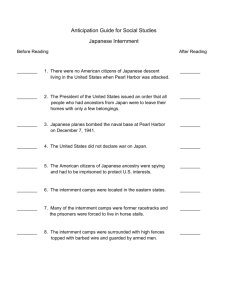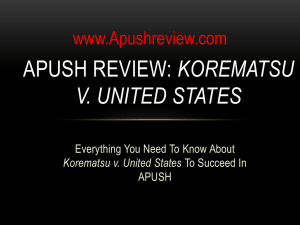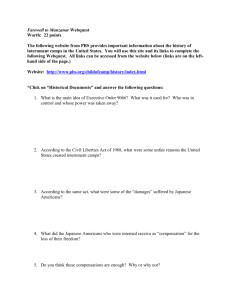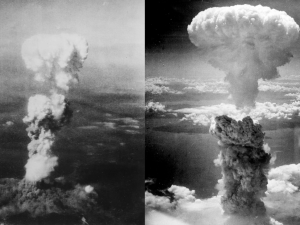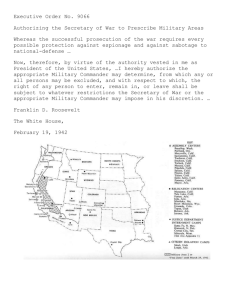Understanding the Civil Liberties Act of 1988
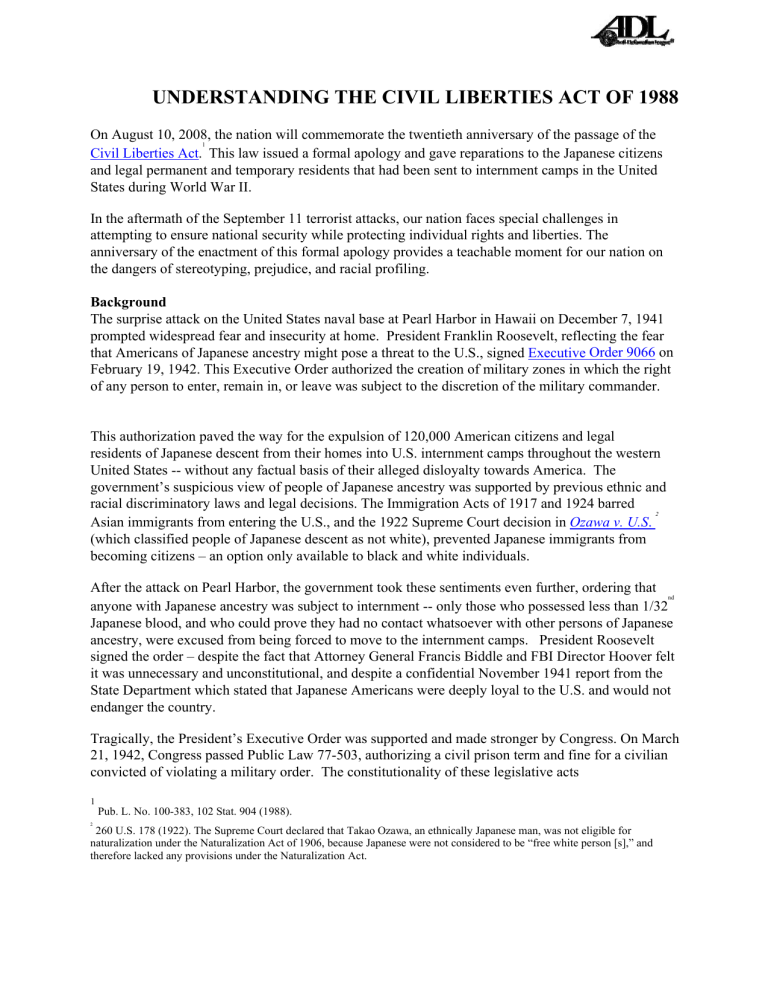
UNDERSTANDING THE CIVIL LIBERTIES ACT OF 1988
On August 10, 2008, the nation will commemorate the twentieth anniversary of the passage of the
1
Civil Liberties Act .
This law issued a formal apology and gave reparations to the Japanese citizens and legal permanent and temporary residents that had been sent to internment camps in the United
States during World War II.
In the aftermath of the September 11 terrorist attacks, our nation faces special challenges in attempting to ensure national security while protecting individual rights and liberties. The anniversary of the enactment of this formal apology provides a teachable moment for our nation on the dangers of stereotyping, prejudice, and racial profiling.
Background
The surprise attack on the United States naval base at Pearl Harbor in Hawaii on December 7, 1941 prompted widespread fear and insecurity at home. President Franklin Roosevelt, reflecting the fear that Americans of Japanese ancestry might pose a threat to the U.S., signed Executive Order 9066 on
February 19, 1942. This Executive Order authorized the creation of military zones in which the right of any person to enter, remain in, or leave was subject to the discretion of the military commander.
This authorization paved the way for the expulsion of 120,000 American citizens and legal residents of Japanese descent from their homes into U.S. internment camps throughout the western
United States -- without any factual basis of their alleged disloyalty towards America. The government’s suspicious view of people of Japanese ancestry was supported by previous ethnic and racial discriminatory laws and legal decisions. The Immigration Acts of 1917 and 1924 barred
Asian immigrants from entering the U.S., and the 1922 Supreme Court decision in Ozawa v. U.S
.
2
(which classified people of Japanese descent as not white), prevented Japanese immigrants from becoming citizens – an option only available to black and white individuals.
After the attack on Pearl Harbor, the government took these sentiments even further, ordering that anyone with Japanese ancestry was subject to internment -- only those who possessed less than 1/32 nd
Japanese blood, and who could prove they had no contact whatsoever with other persons of Japanese ancestry, were excused from being forced to move to the internment camps. President Roosevelt signed the order – despite the fact that Attorney General Francis Biddle and FBI Director Hoover felt it was unnecessary and unconstitutional, and despite a confidential November 1941 report from the
State Department which stated that Japanese Americans were deeply loyal to the U.S. and would not endanger the country.
Tragically, the President’s Executive Order was supported and made stronger by Congress. On March
21, 1942, Congress passed Public Law 77-503, authorizing a civil prison term and fine for a civilian convicted of violating a military order. The constitutionality of these legislative acts
1
Pub. L. No. 100-383, 102 Stat. 904 (1988).
2
260 U.S. 178 (1922). The Supreme Court declared that Takao Ozawa, an ethnically Japanese man, was not eligible for naturalization under the Naturalization Act of 1906, because Japanese were not considered to be “free white person [s],” and therefore lacked any provisions under the Naturalization Act.
was challenged in two cases before the U.S. Supreme Court, Hirabayashi v. U.S.,
3
and Korematsu v. U.S
.
4
Unfortunately, these cases declared the discriminatory actions by the U.S. government to be constitutional and justified.
Gordon Hirabayashi was a Japanese-American student who was convicted of crimes when he refused to comply with the government order requiring him to report to an assigned Civil Control Station.
Hirabayashi claimed the convictions against him were unconstitutional under the Fifth Amendment’s
Due Process Clause, which guarantees that before depriving a citizen of “life, liberty, or property,” the government must follow fair and equitable procedures. However, in 1943 the U.S. Supreme
Court disagreed with Hirabayashi. The Court held that forced displacement and internment of
Japanese Americans like Hirabayashi were within the war powers of Congress and the Executive. The
Court claimed, “The fact alone that attack on our shores was threatened by Japan, rather than another enemy power, set these citizens apart from others who have no particular associations with Japan.”
5
The next year, in 1944, the U.S. Supreme Court again sided with the government in Korematsu v. United States . In a 6-3 decision, the Court decided that the conviction of Fred Korematsu, a
U.S. citizen of Japanese ancestry who violated the order to evacuate his home and report to an assembly center, was justified because the government was protecting American security and military necessity. Writing for the Court, Justice Hugo Black held:
Korematsu was not excluded from the Military Area because of hostility to him or his race. He was excluded because we are at war with the Japanese Empire, because the properly constituted military authorities feared an invasion of our West Coast and felt constrained to take proper security measures, because they decided that the military urgency of the situation demanded that all citizens of Japanese ancestry be segregated from the West Coast temporarily, and finally, because Congress, reposing its confidence in this time of war in our military leaders -- as inevitably it must -- determined that they should have the power to do just this.
6
Justice Black’s words cast a dark shadow over this period of American history – a time in which constitutional freedoms were set aside and discrimination against citizens on the basis of their national origin was permitted and supported by all three branches of the federal government – the
Executive, the Legislative and the Judicial.
Attempts to Remedy Discriminatory Actions
Those forced into internment camps lost their homes and possessions – and their personal liberties and freedoms guaranteed by the United States Constitution. In fact, not a single
3
320 U.S. 81 (1943).
4
323 U.S. 214 (1944)
5
Hirabayashi , at 101.
6 Korematsu, at 223.
documented act of disloyalty or espionage by a person of Japanese ancestry on the West Coast was reported during World War II.
Many years later, in April, 1976, President Gerald Ford rescinded Executive Order 9066. Four years later, in 1980, President Jimmy Carter signed legislation creating the Commission on Wartime
Relocation and Internment of Civilians, a government body designed to investigate the impact of
Executive Order 9066 and the internment camps on the citizens and residents of Japanese ancestry.
The Commission issued its report, Personal Justice Denied , in 1983. The report concluded that the government internment policies were not justified by military necessity. The report also called for a
Congressional joint resolution apologizing for the injustices against those of Japanese ancestry and issuing recommendations for remedies to the surviving internees and their families.
After the issuance of this report, Korematsu and Hirabayashi petitioned for formal review of their convictions, arguing that the U.S. government intentionally misled the Court during the 1944 case as to whether those of Japanese ancestry posed a real threat to the U.S. ADL filed amicus briefs in support of both Korematsu and Hirabayashi. Amicus (“Friend of the Court”) briefs are legal documents presented by an affected party outside the case that attempt to persuade the Court to decide the case a certain way. In 1984, the Federal District Court for the Northern District of
California overturned Korematsu’s conviction.
7
The brief on behalf of Mr. Hirabayashi asked the court to reverse the conviction “to deter government action detrimental and dangerous to the civil liberties of all Americans” -- to prevent future abuses by the government. The 9th Circuit Court of
Appeals granted the petition in 1987.
8
The Civil Liberties Act of 1988
In 1988, the U.S. gave formal recognition to the grave injustices committed against Japanese-
American citizens and residents during World War II with the passage of the Civil Liberties Act.
Sponsored by Representative Norman Mineta (D-CA), a child internee, and Senator Alan Simpson
(R-WY), who first met Mineta while visiting the internment camps, the Civil Liberties Act of 1988 was designed to recognize and apologize for the injustices committed against Japanese-American citizens and residents by the U.S. government during World War II. The Act established a trust fund to provide a measure of monetary reparations to those that had been unjustly interned, and created a public education fund to ensure that the period of Japanese internment would not be forgotten or repeated.
7
584 F. Supp. 1406 (N.D. Cal. 1984).
8
828 F.2d 591 (9 th
Cir. 1987). ADL filed an amicus brief in a related case, Hohri v. U.S. 482 U.S. 64 (1987) . This 1986 case was brought by internees against the government seeking compensation for property taken from Japanese Americans without due process of law. ADL’s brief argued that the government’s harsh treatment of Japanese Americans resulted in a stigma against them of racial inferiority and of disloyalty. However, the Court found jurisdictional issues with the case and did not decide the case on its merits.
In 1990, the government distributed individual redress payments of $20,000 (equivalent to
$31,728 in 2007 dollars) to an estimated 60,000 surviving Japanese Americans who were affected by the internment, along with its apology for the treatment of Japanese Americans during World War II. ADL submitted its testimony in support of the legislation.
It is important that we continue to teach the lessons of the unjust and discriminatory internment of
Japanese Americans during World War II, the dangers of government stereotyping and profiling, and how fear may lead to intolerance.


